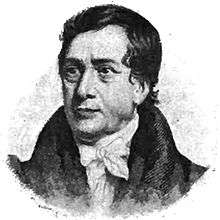Henry Nott
| Henry Nott | |
|---|---|
 Missionary to Tahiti | |
| Born |
1774 Broomsgrove, England |
| Died |
2 May 1844 Paparā, Tahiti |
Henry Nott (1774–1844) was a British Protestant Christian missionary to Tahiti, Society Islands, Polynesia.
Life
He was one of the first missionaries sent out by the London Missionary Society, arriving in Tahiti aboard the mission ship “Duff” in 1797. He had been a bricklayer by trade and the mission did not prepare these missionaries well for their situation in Tahiti. The "Duff" took a year to return to England. Then, when it was loaded with supplies and returning to Tahiti, it was taken by a French ship, Britain and France being at war during the reign of Napoleon.[1]
During the five-year wait for resupply, several of his fellow missionaries deserted, died, or seemed to go mad. Nott continued on, building a relationship with the new king, Pomare II. Nott did not see his first convert until he had been in Tahiti 22 years, Pomare II. Nott learned the language and worked with Pomare II on translating the Bible into the Tahitian language.
He married a newly arrived missionary from Britain, but she was not content in Tahiti and died within two years.
Nott returned to England only two times during 47 years overseas and was the primary translator of the Bible into the Tahitian language.[2]
Missionary historian Ruth A. Tucker wrote:
But for the perseverance of Henry Nott, the work in Tahiti would no doubt have been abandoned.[3]
Henry Knott died in 1844
References
- Garrett, John (1998). Biographical Dictionary of Christian Missions, pp. 500,501. New York: Simon & Schuster Macmillan.
- Tucker, Ruth (1983). From Jerusalem to Irian Jaya A Biographical History of Christian Missions. Grand Rapids, Michigan: Zondervan. ISBN 0-310-23937-0.
- Lovett, Richard (1899). The History of the London Missionary Society 1795-1895. London: London Missionary Society.
- Horne, C. Sylvester (1904). The Story of the L.M.S. London: London Missionary Society.
Popular Biography
Joyce Reason. The Bricklayer and the King: Henry Nott of the South Seas. London, Edinburgh House, 1938.
